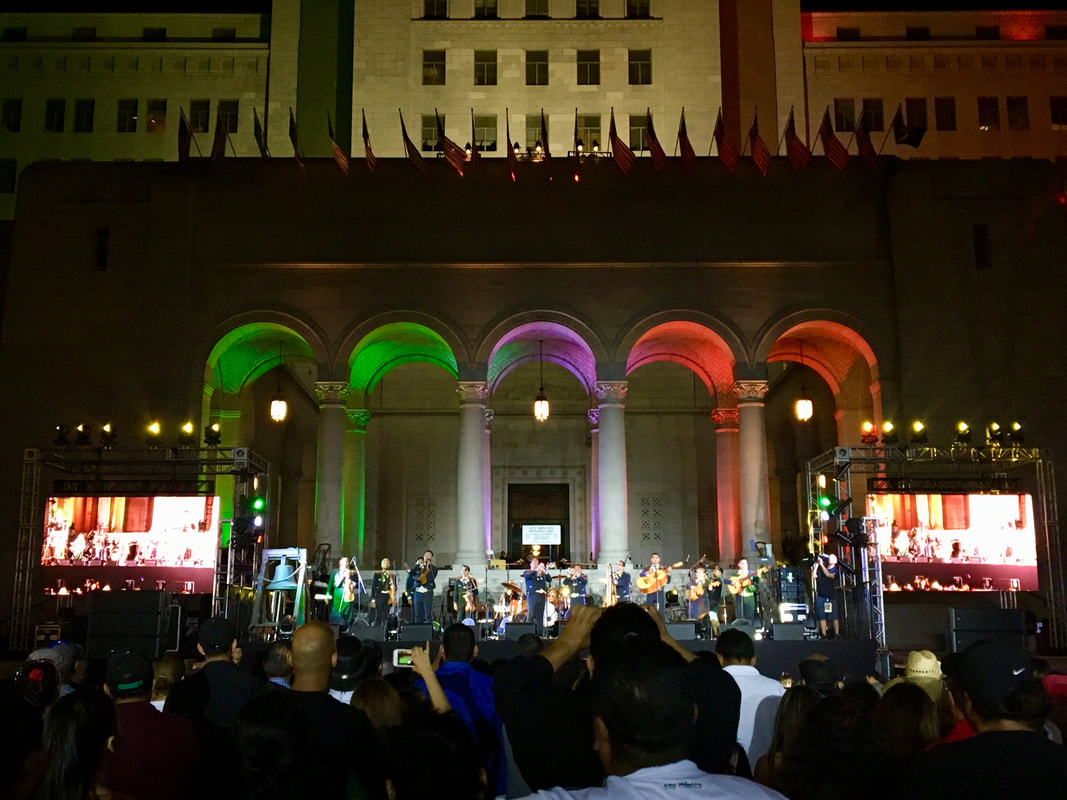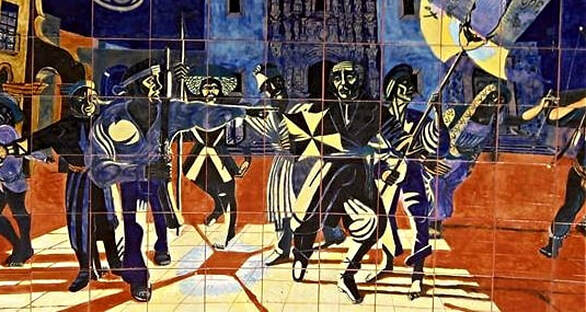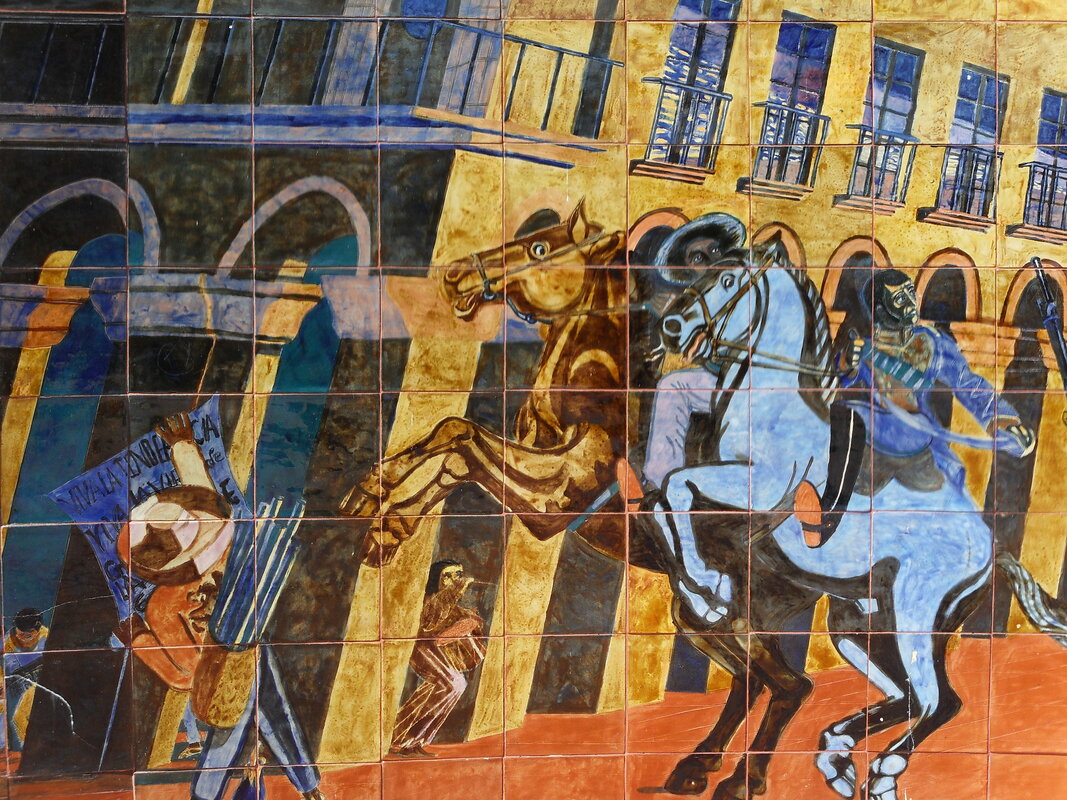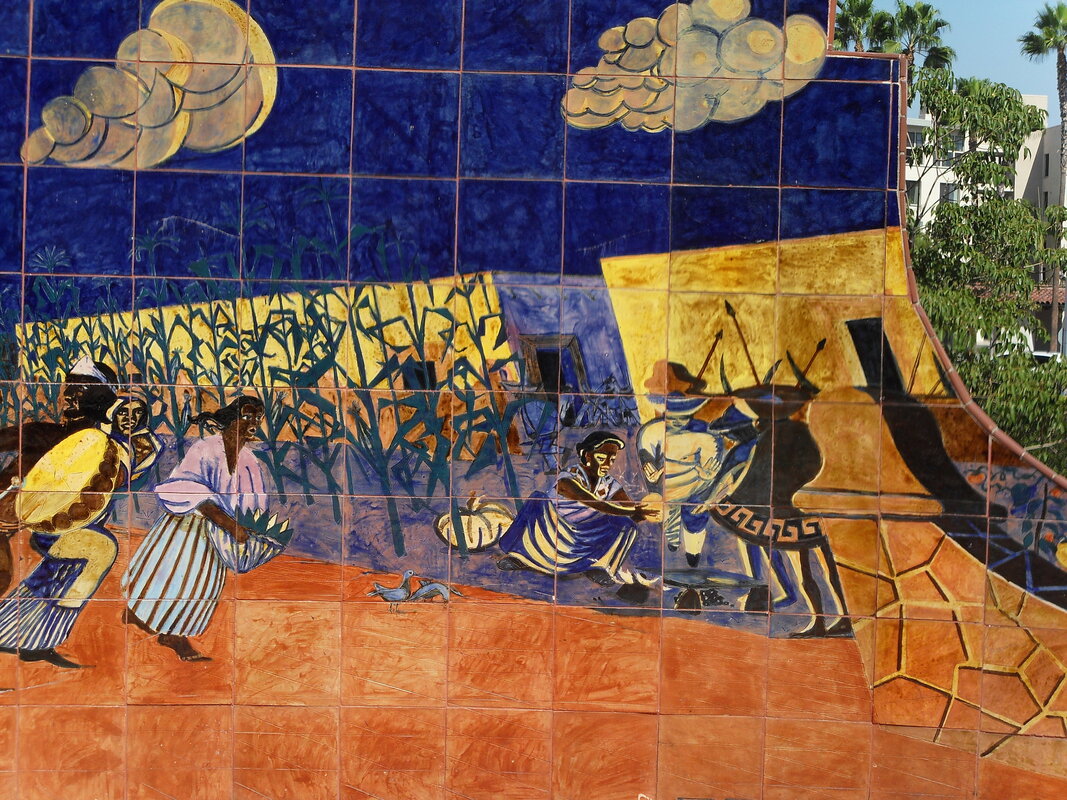|
Each year Mexican people celebrate the 16th of September in commemoration of the 1810 start of what became the Mexican independence movement. The colorful patriotic festival is celebrated not only within Mexican national boundaries, but also on the other side of its northern border wherever great concentrations of Mexican communities are found. In Los Angeles, California the demographic and cultural strength of the Mexican community – the second largest in the world after Mexico City – makes celebrating the annual “fiestas patrias” an indispensable local tradition. A colorful ceramic mural located in the historic heart of L.A. titled El Grito (“The Cry”) celebrates Mexico’s independence and as well as the heritage of the city’s vibrant Mexican American community. A plaza situated near the Los Angeles’s Union Station and the Hollywood Freeway (U.S. 101) signifies the historic Spanish-Mexican roots of the United States’ second-largest city. The historic Los Angeles Plaza (sometimes known as “la Placita Olvera” due to the popularity of the neighboring Olvera Street and its Mexican-themed stores) was the city’s center from its founding in 1781 until the 1880s. By that point Los Angeles was no longer an outpost in the far north of New Spain (after 1821) or Mexico (after 1848). The arrival of the Southern Pacific Railroad in the 1876 propelled a population boom in L.A. as thousands of internal migrants from the eastern U.S. and midwestern states moved to Southern California – the city’s growth subsequently moved south of the historic plaza as the city shed much of its Mexican influence. Despite the social dispossession experienced by the Mexican community, the Los Angeles Plaza continued being the site where the “fiestas patrias” were celebrated. In the above image, a four-piece band performed during the 1940 Mexican Independence Day celebrations at the Los Angeles Plaza. [2] Today Mexican independence day celebrations in L.A. are mainly held at Los Angeles City Hall and are typically broadcast by the Telemundo and Univision networks, even though smaller (but no less meaningful) celebrations are still held in the Los Angeles Plaza. During the independence day festivities held on September 15, 2018, Mariachi Arcoiris de Los Angeles (the first LGBT-themed group in the mariachi genre) and other entertainers such as Selenamos (honoring singer Selena Quintanilla) and Los Tucanes de Tijuana headlined the night’s musical program.
Back at the Los Angeles Plaza, the public can reacquaint themselves with L.A.’s Mexican heritage and the long legacy of Mexican Independence Day there by visiting a large ceramic mural located just off the historic plaza in a connected area called “La Placita Dolores.” Dedicated in 1979 along with the Placita de Dolores, the mural El Grito commemorates the famous events of the morning of September 16, 1810 in front of the church in Dolores, Guanajuato, when the priest Miguel Hidalgo y Costilla shouted (“cried”) out a rousing speech to convince the population to fight against the Spanish colonial government, leading to the beginning of what became Mexico’s independence movement. The colorful mural formed by 300 painted ceramic tiles was created by Mexican American artist Eduardo Carrillo of Los Angeles who used art students to help him install his project [4]. Carrillo, descended from a Mexican family with roots in the mission town of San Ignacio, Baja California Sur, was a faculty member of the University of California, Santa Cruz when he developed his ceramic mural. After his death in 1997, Carrillo was remembered as an advocate of youth art education. Inspired by his boyhood in the Baja Californian peninsula, Carrillo is also remembered as a great muralist within the Chicano Movement of the 1960s and 1970s – one of his most famous works is Chicano History in the University of Los Angeles’s Campbell Hall. [6] The El Grito mural, a replica of the bell Father Hidalgo rang in Dolores, Guanajuato, and the rest of the Placita de Dolores were officially dedicated by U.S. President Jimmy Carter on May 5, 1979. Speaking to nearly 1000 attendees, Carter highlighted the role of federal grants in beautifying the Los Angeles Plaza and also reiterated his support for immigration reform: “I’m committed to making sure that all the people – all the people – within our borders, no matter how they may have gotten here, are treated always with dignity and with justice. And I am also committed to protecting the basic human rights of every person in this country, whatever their legal status might be.” [7]  During his visit to L.A., Mr. Carter stayed overnight with the family of architect Stephen Rodriguez in the Los Angeles neighborhood of El Sereno. The morning before he dedicated “El Grito” and the Placita de Dolores, Carter went for a run with Rodriguez and his young son Stephen at Woodrow Wilson High School. [8]
The Los Angeles Plaza is a public space that links the busy cosmopolitan city with its historic Mexican roots. Although in linguistic and cultural identity terms the L.A. Mexican American community faces great pressure to assimilate into white, English-speaking mass society, the El Grito mural and the Placita de Dolores – along with the annual Mexican Independence Day and separate Cinco de Mayo celebrations – affirm the Mexican essence of Los Angeles’s development and growth. The international border is not the border for the celebration of Mexican cultural identity. Eduardo Carrillo’s El Grito and the Placita de Dolores are located at 831 N. Alameda St., Los Angeles, CA. Notes:[1] “Discover Olvera Street and Historic El Pueblo de Los Angeles ,” Discover Los Angeles, Sept. 28, 2018 (https://es.discoverlosangeles.com/blog/guide-olvera-street-downtown-los-angeles).
[2] “Four piece band surrounded by crowd at Mexican Independence Day on Olvera Street, Los Angeles, 1940” Los Angeles Times Photographic Archive , UCLA Library (http://digital2.library.ucla.edu/viewItem.do?ark=21198/zz0002vg1n&imageonly=true). [3] “Proyectando la conciencia Mexicana,” La Opinión, Sept. 16, 1976 (Sect. 7, Pg. 4). Mr. Martinez Manatou gave the commemorative “cry of Dolores” in L.A. on behalf of his friend, Mexican President Gustavo Diaz Ordaz. [4] “Eduardo Carrillo,” Mural Conservancy of Los Angeles (https://www.muralconservancy.org/artist/eduardo-carrillo). [5] Photos by Cruz Ortiz Zamarron, “Murals: El Grito,” Museo Eduardo Carrillo (https://museoeduardocarrillo.org/gallery/murals/) [6] “UCSC art professor dies in Mexico at age 60,” Santa Cruz Sentinel (originally published Sept. 12, 1997), Museo Eduardo Carrillo (https://museoeduardocarrillo.org/santa-cruz-sentinel-biography/); Michael Several, “Eduardo Carrillo,” Public Art in L.A. (http://www.publicartinla.com/UnionStation/carillo_bio.html) [7] “Speech by President Carter,” Los Angeles Photographers Photo Collection, Los Angeles Public Library (http://tessa.lapl.org/cdm/ref/collection/photos/id/125842); “Interés de Carter por los chicanos,” La Opinión (6 de mayo 1979), 1, 2; “Remarks at Dedication Ceremonies for La Placita de Dolores de Los Angeles,” May 5, 1979, Public Papers of the Presidents of the United States: Jimmy Carter, 1979 (Book I, January 1-June 22, 1979), pgs. 809-810.; “The Daily Diary of President Jimmy Carter,” May 5, 1979, President Jimmy Carter Library (https://www.jimmycarterlibrary.gov/assets/documents/diary/1979/d050579t.pdf). [8] “U.S. President Jimmy Carter on morning run with Stephen Rodriguez in El Sereno, Calif., 1979,” Los Angeles Times Photographic Archive , UCLA Library (http://digital2.library.ucla.edu/viewItem.do?ark=21198/zz0002qs8t) #california #miguelhidalgo #elgrito #eduardocarrillo #plazadelosangeles #placitadedolores #mexico #independenciademexico #chicanos #mexicanos #placitaolvera
4 Comments
Cruz Zamarron
9/7/2019 19:22:04
I was one of the apprentices who helped draft the full scale drawings, along with Victoria Petrovich. I drew the church bldg. It was a great and rewarding experience. Eduardo was a genius and master of light...
Reply
11/16/2021 11:51:52
Cruz the towering church's commanding presence is glorious.
Reply
Leave a Reply. |
Carlos Parra
U.S.-Mexican, Latino, and Border Historian Archives
January 2021
Categories
All
|




















 RSS Feed
RSS Feed